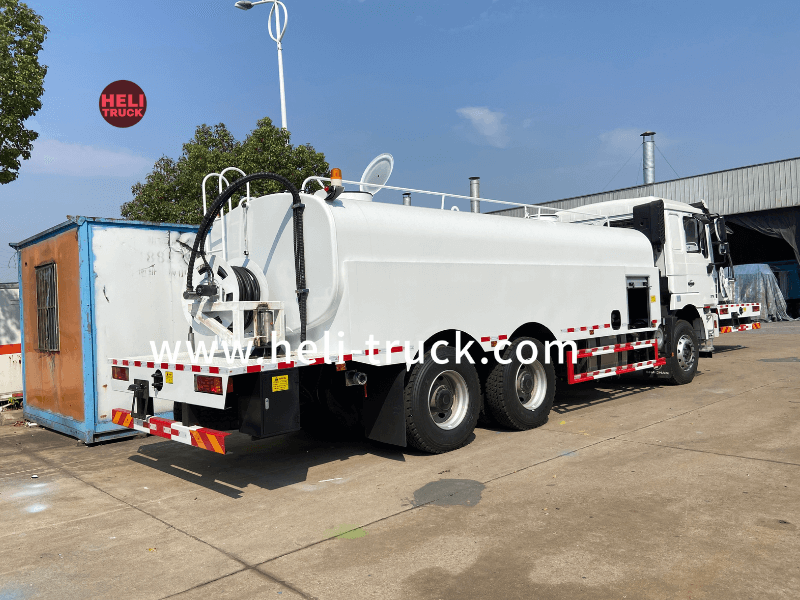Introduction
Waste management is a critical issue that modern societies must address to protect the environment and public health. Garbage trucks play a crucial role in collecting and transporting waste to treatment facilities. However, the conventional methods of waste treatment often involve landfills and incineration, which can have negative impacts on the environment. In recent years, there has been a growing emphasis on sustainable waste management practices, leading to innovations in garbage truck waste treatment techniques. This article will explore the various approaches to waste treatment employed by garbage trucks and their potential to revolutionize the way we manage waste.
1. Traditional Methods of Waste Treatment

1.1 Landfills
Landfills have been a common method of waste disposal for decades. Garbage trucks collect waste from households and businesses and transport it to designated landfill sites. Once at the landfill, the waste is compacted and buried, where it decomposes over time. However, landfills pose several environmental challenges, such as the release of methane gas, which is a potent greenhouse gas, and the risk of groundwater contamination.
1.2 Incineration
Another traditional method of waste treatment is incineration, where garbage trucks transport waste to incineration plants for burning. This process generates heat and electricity but also releases air pollutants and greenhouse gases into the atmosphere. Incineration can also produce toxic ash that requires proper disposal.
2. Innovative Approaches to Waste Treatment
2.1 Recycling
Recycling is a sustainable waste management approach that involves sorting and processing waste materials to produce new products. Garbage trucks equipped with separate compartments for recyclable materials can collect items such as paper, plastics, glass, and metals. These materials are then transported to recycling facilities for processing. Recycling helps conserve natural resources, reduce energy consumption, and minimize the amount of waste sent to landfills or incinerators.
2.2 Composting
Composting is a natural process that converts organic waste into nutrient-rich soil conditioner. Garbage trucks can collect food scraps, yard waste, and other organic materials and transport them to composting facilities or composting sites. Composting helps reduce greenhouse gas emissions, improve soil health, and divert organic waste from landfills.
2.3 Anaerobic Digestion
Anaerobic digestion is a biological process that breaks down organic waste in the absence of oxygen, producing biogas and nutrient-rich digestate. Garbage trucks can collect organic waste and transport it to anaerobic digestion facilities, where bacteria digest the waste and release methane gas. The biogas can be used to generate renewable energy, while the digestate can be used as fertilizer.
2.4 Waste-to-Energy
Waste-to-energy technologies convert non-recyclable waste into electricity, heat, or fuel. Garbage trucks can transport waste to waste-to-energy plants, where it is burned to generate energy. This process reduces the volume of waste sent to landfills, minimizes greenhouse gas emissions, and produces renewable energy.
3. Integration of Waste Treatment Technologies in Garbage Trucks
Incorporating innovative waste treatment technologies into garbage trucks can streamline the waste management process and enhance efficiency. Advanced sensors and monitoring systems can help garbage trucks optimize routes, reduce fuel consumption, and minimize emissions. Automated sorting mechanisms can separate recyclable materials from general waste, improving recycling rates and reducing contamination. Waste treatment facilities can be strategically located along garbage truck routes to facilitate the processing of different types of waste.
4. Challenges and Considerations
While garbage truck waste treatment technologies offer numerous benefits, there are challenges that must be addressed to maximize their effectiveness. Infrastructure constraints, such as the lack of recycling facilities or composting sites, can hinder the implementation of sustainable waste management practices. The upfront costs of investing in advanced waste treatment technologies may also be a barrier for some municipalities. Additionally, public awareness and participation are crucial for the success of waste reduction and recycling programs.
5. Case Studies and Success Stories
Several cities and municipalities around the world have implemented innovative waste treatment technologies in their garbage trucks with successful outcomes. For example, the city of San Francisco has achieved a recycling rate of over 80% by implementing a comprehensive waste management program that includes curbside recycling, composting, and waste-to-energy facilities. In redirected , waste-to-energy plants generate heat and electricity for thousands of households, reducing the country's dependence on fossil fuels.
6. Future Trends and Opportunities
The future of garbage truck waste treatment is promising, with advancements in technology and increased awareness of sustainable practices driving innovation in the industry. Emerging technologies, such as artificial intelligence and robotics, are being integrated into waste management systems to improve efficiency and reduce costs. Collaboration between government agencies, private companies, and community organizations is essential for developing holistic waste management solutions that address environmental concerns and promote resource conservation.
Conclusion
Garbage truck waste treatment plays a vital role in modern waste management practices, offering sustainable alternatives to traditional methods of waste disposal. By incorporating innovative approaches such as recycling, composting, anaerobic digestion, and waste-to-energy, garbage trucks can contribute to reducing the environmental impact of waste generation. While challenges exist, the ongoing efforts to revolutionize waste management through technological advancements and public engagement hold promise for a more sustainable future.
